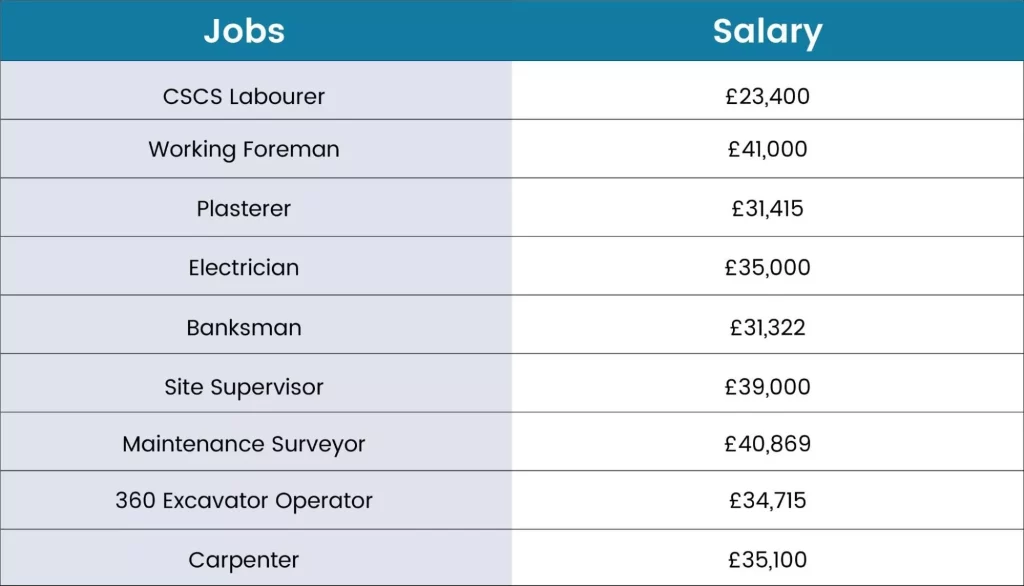Temporary works are required for almost every construction project, but it is often misunderstood what temporary works are and how we can manage them efficiently. Just like permanent work, temporary works in construction have their own significance in building projects.
In this blog, I’ll provide valuable insights and explore the main purpose of temporary works, such as site clearing and excavations. We’ll also explore the various aspects of temporary work, from the types of jobs you can have as a temporary worker to tips to manage temporary works efficiently.
What Are Temporary Works in Construction?
Temporary works can be defined as an engineered solution used to facilitate the construction of permanent works. Once the construction work is completed, they are often removed. Common examples of temporary works in construction are scaffolding and hoarding.
According to the Code of Practice for temporary works procedures “BS 5975 Design Temporary Falsework”, temporary works are designed to support or protect a structure during construction, an item of plant or equipment, and the sides of excavation during construction operations, or to provide access.
To understand this term more precisely, let’s explore the difference between temporary works and permanent works in construction.
Temporary Works Vs. Permanent Works in Construction
Permanent Works | Temporary Works | |
What is it? | Permanent site works are the structure that is the permanent part of the design. | This type of construction work is a component of the project that allows you to construct permanent site work. |
Where is it required? | It is required for the entire lifespan of the structure. | These works are required for a certain period of time to execute certain construction activities. |
Examples | Walls, roads, parking, ponds and canals, and landscaping. | Site clearing, demolition of abandoned structures, evacuations, and scaffoldings. |
What are the Different Types of Temporary Site Works in Construction?
There are a number of temporary works in the construction industry. Let’s explore the most common ones below.
Types of Temporary Works | Description |
Site Clearing | It involves cutting trees and removal of bushes and topsoil. These are done by using machines such as backhoes, dozers, clearing rakes, and stump splitters. |
Demolition of Abandoned Structures | This includes the deconstruction of abandoned concrete, steel, and masonry structures. |
Mass Grading | The process of obtaining the right elevation of the ground is known as mass grading. It is done by dozers, excavators, and loaders after demolition and site clearing. |
Scaffolding | This type of temporary works are used to support workers and their equipment during the construction, maintenance, and repair of buildings, bridges, and other man-made structures. It provides a safe working environment for inspection, access, and construction. |
Formwork | Formwork refers to the moulding/shaping of concrete into structural shapes (beams, columns, slabs, shells) for buildings, bridges, or any other structure. Any composite material, wood or plastic can be used to make formwork. |
Falsework | Falsework refers to the temporary structure that is built during construction to hold up the permanent structure to the point where it can stand alone without any temporary support. Falsework includes temporary supports for formwork, which is used to mould concrete when elevated roads, bridges, and structures are being built. |
Shoring | A temporary structure called shoring is used to keep the main building, which is still under construction, from collapsing. In general, it’s important to safeguard nearby buildings, stabilise the walls of the construction pit, and stop water from getting into the pit. |
Cranes | Cranes are used in the construction of bridge superstructures and substructures. Cranes can also act as bridges, allowing concrete to move to inaccessible areas. Floating cranes, bridge cranes, or gantry cranes are common examples of crane equipment. |
Temporary Construction Jobs and Their Salaries
Construction sites that are only set up for a short time have many different jobs.

Why is There a Need for Temporary Work?
Temporary works provide safety to crew staff involved in the construction. Secondly, it provides adequate strength to the permanent structure, which is extremely important in achieving the required structure. As concrete takes time to harden, structural members are held in place with props until the desired strength is reached. Sometimes temporary works also shift and is incorporated into permanent works such as haul road foundations and crane and pilling platforms.
Thirdly, it allows access to areas where construction is taking place. You’ve probably seen workers using shuttering to gain entry into areas where access is not possible. When planning a new build, it’s important to include temporary works in your budget, as they form a key part of overall home construction expenses.
How to Manage Temporary Works in Construction?
Among all industries, the construction industry has the highest rate of fatal injuries. Though there is no specific legal requirement for how to manage temporary work, there are certain measures you can take to ensure safety.
- Hire temporary works Coordinators: Typically, temporary works coordinators (TWC) are hired to manage temporary works efficiently. They help to ensure that the right designs are created, reviewed, and erected on the job site. Moreover, in order to ensure that all work is carried out and coordinated in a manner that does not involve any risk or harm, it is important to appoint a competent work coordinator.
- Focus on Temporary Works Design: All equipment and items of temporary works must be designed with meticulous details and attention. The instructions provided by the equipment manufacturer must be followed when selecting and using temporary support or the product manual, e.g. standard scaffold or hoarding system.
CSCS Training Courses
Upon finishing the Green CSCS Card Course or the Level 1 Health and Safety in a Construction Environment, you can apply for the CSCS Green Card.
This card will qualify you for employment on construction sites in various entry-level roles, such as bricklayer, carpenter, or plumber.
CSCS courses are important for anyone in the construction industry, whether you are a labourer, tradesperson, or manager. The card demonstrates that you possess the required training and qualifications for your specific role on-site.
Frequently Asked Questions (FAQs)
What are the risks of temporary work?
The major risks associated with temporary works include the collapse of structures, the falling of objects, excavation collapses, and getting struck by moving machinery. Additionally, if temporary works are not carried out properly it also results in financial, health, and safety loss.
Do I need a CSCS card for temporary works in construction?
Yes, you will need a valid CSCS card for temporary works on the construction site, whether you’re a skilled labour or site supervisor. Though getting a CSCS card is not a legal requirement, you must still get it in order to gain access to the construction site or to qualify for any job. There are several types of CSCS cards, and you can get any one of these depending on your qualifications and experience.
What is temporary formwork?
Formwork is used for temporary moulding to form concrete into structural shapes for buildings, bridges, and other structures.
What are temporary structures?
Any structure that is only intended to perform a specific function temporarily rather than for long-term use is considered to be “temporary.” These structures are created to meet a short-term need, lasting hours, days, weeks, or even months rather than years.
What are the advantages of temporary construction?
There are many advantages of temporary construction. These structures are:
- Cost efficient
- Highly customisable
- Can be installed quickly
- Can be shifted and incorporated into permanent works
- Provides adequate strength to the permanent structure
What are the different kinds of temporary structures?
Temporary structures come in various forms, including canopies, garages, sizable greenhouses, barn and farming storage facilities, aeroplane hangars, materials storage facilities, screen houses, and more.
Conclusion
Temporary works in the construction industry hold great importance as they help to build permanent structures. It also provides many job opportunities to construction workers. However, we shouldn’t overlook the fact that the majority of injuries occur during temporary work, which is why it is critical to manage temporary work effectively.




